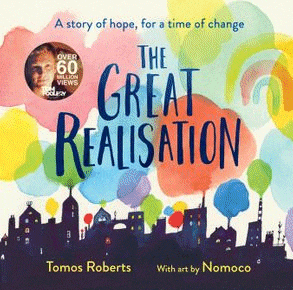
The Great Realisation
The Great Realisation
Tomos Roberts
Nomoco
HarperCollins, 2020
32pp., hbk., RRP $A24.99
9781460759806
London is in lockdown and poet and performer Tomos Roberts finds himself home-schooling his much younger brother and sister. One evening, as he tucks his brother into bed, Cai asks him to tell him the poem “about the virus” again and Roberts obliges.
And so begins a reflection of what the world was like before 2020 when Greed was King and the pursuit of the Almighty Dollar was paramount regardless of the pollution it caused, the damage done to the environment and the consequences to the planet’s health. People’s relationships and connections were lost as we raced lemming-like to some elusive, invisible but seemingly better future.
But then came coronavirus and with it, orders to stay at home and inside. And because of human nature, we reverted to the simpler pleasures of earlier times rebuilding a more sustainable lifestyle that was not dependent on external gratification and validation. And that, in turn, had an effect on our cities and countries as the landscape was allowed to breathe again, if not heal. There was a realisation that there was a different, even better way to live and perhaps this experience and its rewards would be embraced even after the virus was managed. “We all preferred the world we found, to the one we’d left behind.”
Roberts finishes by telling his brother to “lie down and dream of tomorrow, and all the things you can do. And who knows, if you dream hard enough, maybe some of them will come true.”
Roberts first shared this as a video clip and it has been viewed over 60 million times, suggesting that it has a universal message that humanity really wants to hear at this time but it’s production as a picture book with the extraordinary illustrations by Japanese artist Nomoco not only bring the words to life but make it accessible to so many more. Because the spoken word is so fleeting it’s meaning is not always grasped within the moment, but having a print version that can be read and re-read enables the full intent of the words to be appreciated, valued and perhaps acted upon.
While younger readers will recognise some of the events in the story and will be able to talk about what they did when they couldn’t go outside, the full beauty of the words, the pictures and the message is one that more mature readers will appreciate more. This is reflected in the activities in the teaching ideas which I wrote as I found myself going back and forth many times and finding more each time (and am continuing to do so as I write the review!)
This is a unique book – it is factual yet both a reflection and a dream at the same time and one that will become a point of reference for whenever in the future we look back on this year and consider the time the world was changed in a such a profound way that it would never be the same again.
